Japanese Garden, Kibbutz Hephzibah – Visitors Guide
Last Saturday, we joined a guided tour of the Japanese garden at Kibbutz Hephzibah. Why is there a Japanese garden in a Kibbutz? The Japanese Makuya religious movement founded this small and well-kept garden.
Note: Japanese Garden at Kibbutz Hephzibah is a private garden, and you can visit it only by pre-booking a tour. See contact details below.
Table of Contents
Makuya
Makuya, also called Makuya of Christ and based at the Tokyo Bible Seminary, is a religious movement in Japan founded in 1948 by Ikurō Teshima. To grasp the inner truth of Biblical religion, or the “Love of the Holy Spirit” as Teshima puts it, and to extol this existential love by embodying it and living accordingly is the essence of the Makuyas’ religious life. They are fervently identified with the cause of Israel, conceiving the establishment of the State of Israel and the unification of Jerusalem as essentially a fulfillment of biblical prophecies.
Source: Wikipedia
As mentioned above, Makuya members are Christian. Since Christianity originates from Judaism, they see a value in studying Judaism and learning Hebrew, and one of the ultimate goals is to read the Bible in Hebrew. They also see the utmost importance in nurturing relations with the State of Israel.
The members of this religious movement also identify with the values of the Israeli kibbutz movement. This explains the location of the garden.
Usually, Makuya members come to the Kibbutz for several months each year, and they learn Hebrew in Ulpan (an institute or school for the intensive study of the Hebrew language).
Japanese Garden at Kibbutz Hephzibah
The Japanese Garden at Kibbutz Hephzibah was designed by Yohachi Gotto, a gardener artist and a member of Makuya, in 1975, in memory of Ikurō Teshima (Makuya founder).
As I wrote in the beginning, we joined a guided tour. The Japanese garden is a private property of Kibbutz Hephzibah, and entrance is authorized only by setting up a paid guided tour upfront by phone or email. Here is a link to the Japanese Garden Facebook page. Our guide was:
Naama Amit and her contact details are gilamit.hb@bezeqint.net, 054-6634348.
Another reason to join a guided tour is that Japanese Gardens are very different from Western gardens and parks. Or as Iwatsuki, Zennoske, and Tsutomu Kodama in Economic Botany said: “Western gardens are typically optimized for visual appeal while Japanese gardens are modeled with spiritual and philosophical ideas in mind”. Without a guide, the meaning is lost, and the visitors do not see or grasp all those ideas and cannot fully enjoy their stay.
The view from the parking lot:

The garden is next to the Makuya house (you can see it on the left in the distance). Just behind the gardens, you can see Mount Gilboa. And Harod Valley is behind us.
Entrance to the Japanese Garden:

History
We started our tour with Naama next to the pond. Did you know that Japanese Gardens began in the Asuka period (around 600AD)? During that period, Japanese merchants witnessed gardens built in China and brought many Chinese gardening techniques and styles back to Japan. And only by the Edo period (around 1700) Japanese gardens developed a distinct style of their own.
Japanese gardens create miniature idealized landscapes. Moreover, this garden was inspired by Isaiah 41:18-20:
I will make rivers flow on barren heights, and springs within the valleys. I will turn the desert into pools of water, and the parched ground into springs. I will put in the desert the cedar and the acacia, the myrtle and the olive. I will set junipers in the wasteland, the fir and the cypress together, so that people may see and know, may consider and understand, that the hand of the LORD has done this, that the Holy One of Israel has created it.
Symbolism
The garden has a lot of symbolism (besides having most of the plants as mentioned in the psalm above), and nothing is left to chance. Let’s look at the next photo, for example:
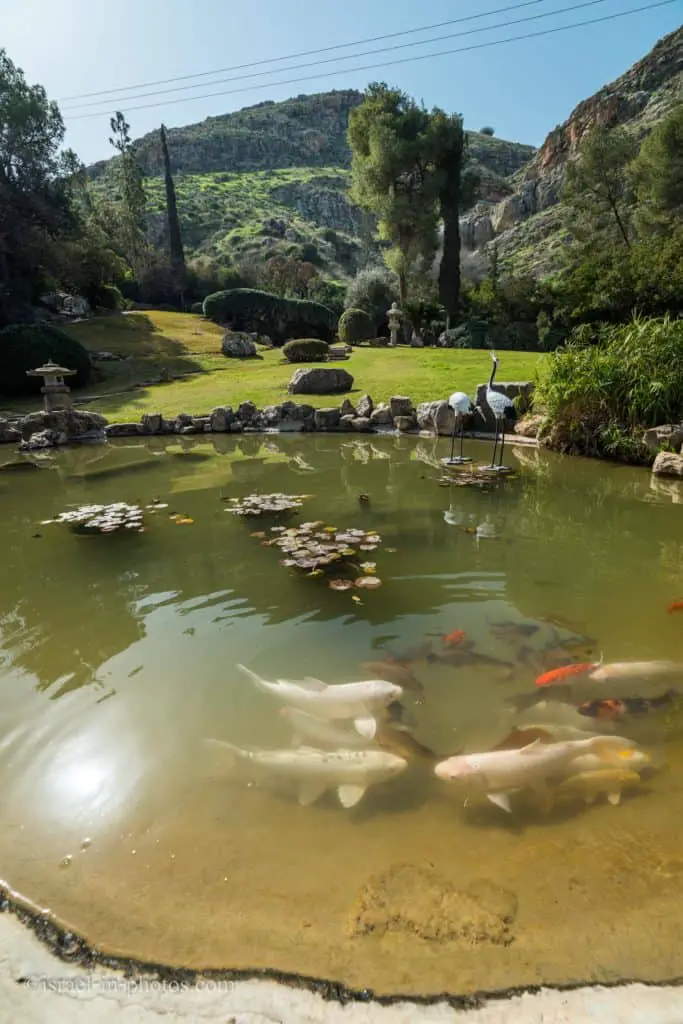
You can see in this small pond Buddhist symbolism. Water and stone are the Yin and Yang, two opposites that complement and complete each other. Therefore, Japanese gardens always have water, either a pond or stream or, in the dry rock garden, represented by white sand.
Koi and Red-Crowned Cranes
In the pond, we can see fish, particularly Koi (colored carp) and goldfish. Do you know how long Koi fish live? Here is a quote from the Guardian:
The age of a fish is calculated in much the same way as one works out the age of a tree by counting its rings; most fish have growth rings on their scales known as annuli. This technique was used to estimate the age of Hanako, meaning “flower maid”, the world’s oldest koi carp, who died in 1977 at the age of 226 years.
For that reason, Koi fish symbolize longevity.
In the pond, you can also see a statue of two red-crowned cranes called the Japanese crane. Because they have red feathers on their heads, some say they carry Japan’s flag on their head. Japanese cranes symbolize luck, longevity, and loyalty (since they have partnered for life).

This metal stand helped the young tree grow. And over the years, the tree wrapped around the stand.

Then Naama told us about the lucky numbers 1,3,5,7 in Japanese culture. She talked about Children’s Day, celebrated on May 5 (5/5). And until recently, Tango no sekku (original Children’s Day) was known as Boys’ Day. In comparison, Girls’ Day was celebrated on March 3 (3/3). And in the next photo, you can see Koinobori (carp-shaped wind socks traditionally flown in Japan to celebrate Tango no sekku).
Stone Lanterns
There are three Japanese stone lanterns in the garden. The lanterns and the bridge are the only stones brought from Japan (the rest are local ones).
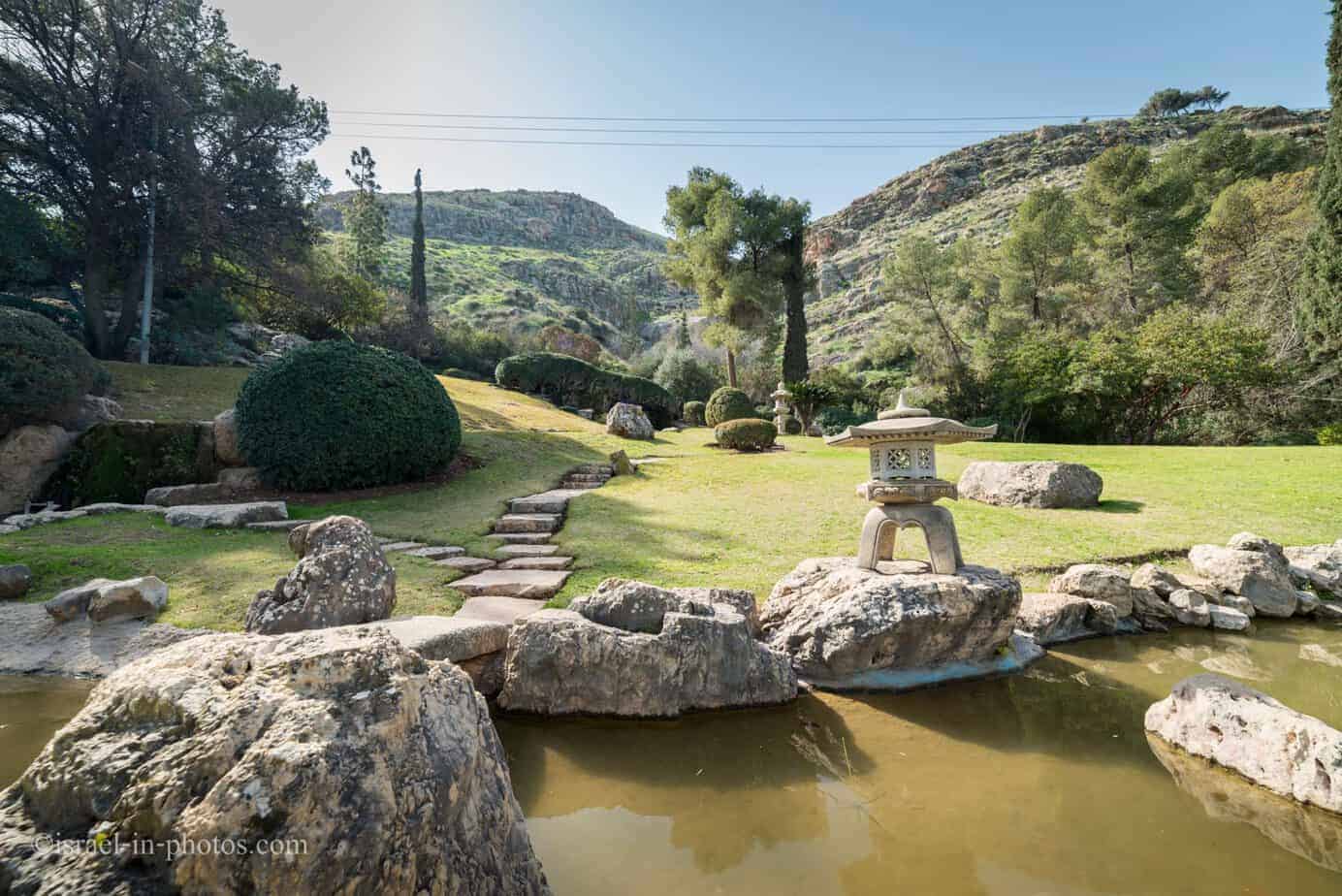
In its complete and original form, a dai-doro, like the pagoda, represents the five elements of Buddhist cosmology. The piece touching the ground represents chi, the earth; the next section represents sui, or water; ka or fire, is represented by the section encasing the lantern’s light or flame, while fū (air) and kū (void or spirit) are represented by the last two sections, top-most and pointing towards the sky. The segments express the idea that after death our physical bodies will go back to their original, elemental form.
Source: onmarkproductions.com

Bamboo can grow up to a meter a day. Bamboos are not trees. They are a kind of grass. The more we use them, the fewer trees we cut. And indeed, modern industry uses them not only in wood and paper products but in the food and beverage industry (like bamboo Beer), bamboo phone cases, clothing, floors, and much more.
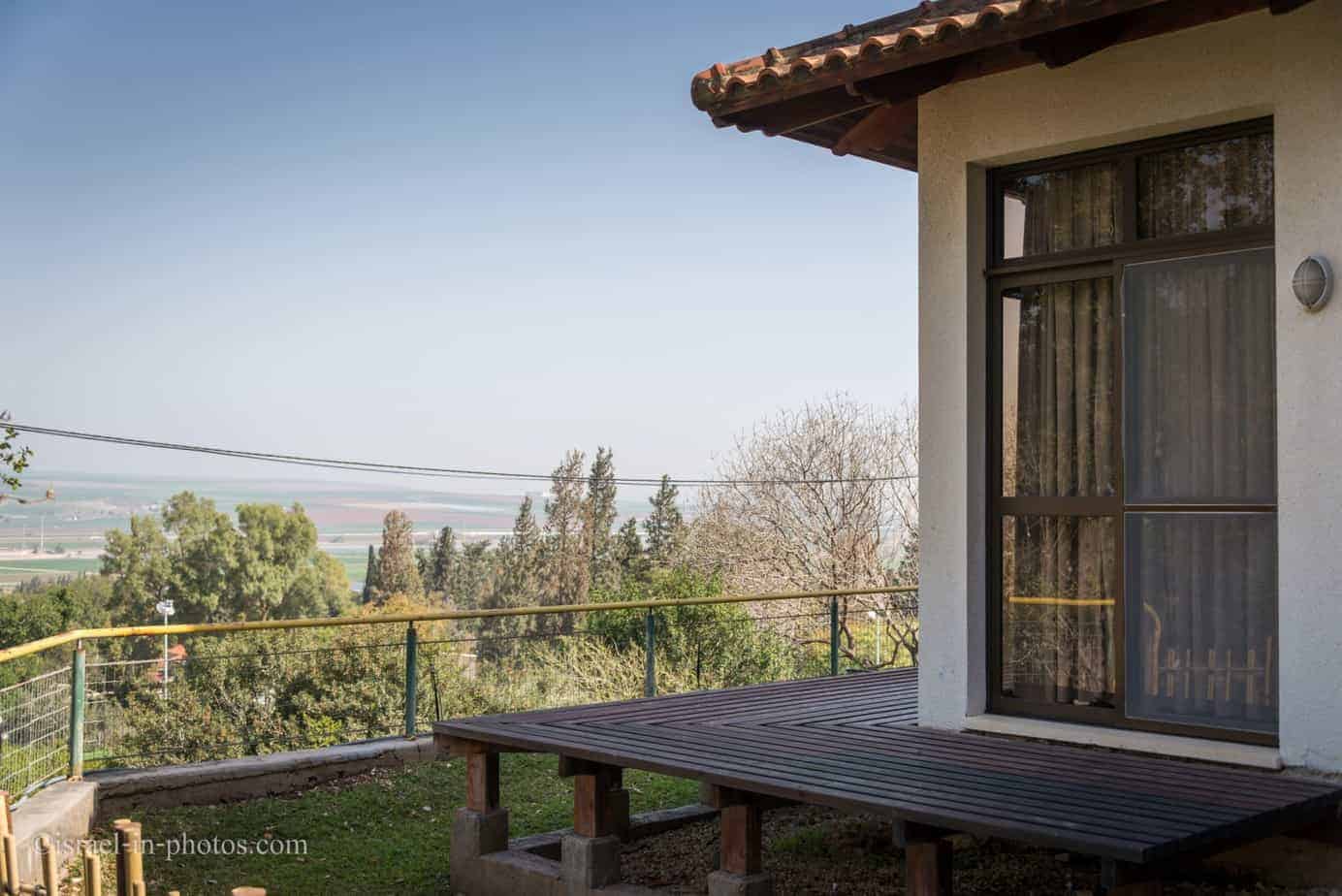
The Wadi and The Cave
In the background of the following photograph, you can see a “crack” in Gilboa mountain. After rainy days, much water flows there, and members of Kibbutz Hephzibah call it chocolate milk wadi (due to its muddy color).
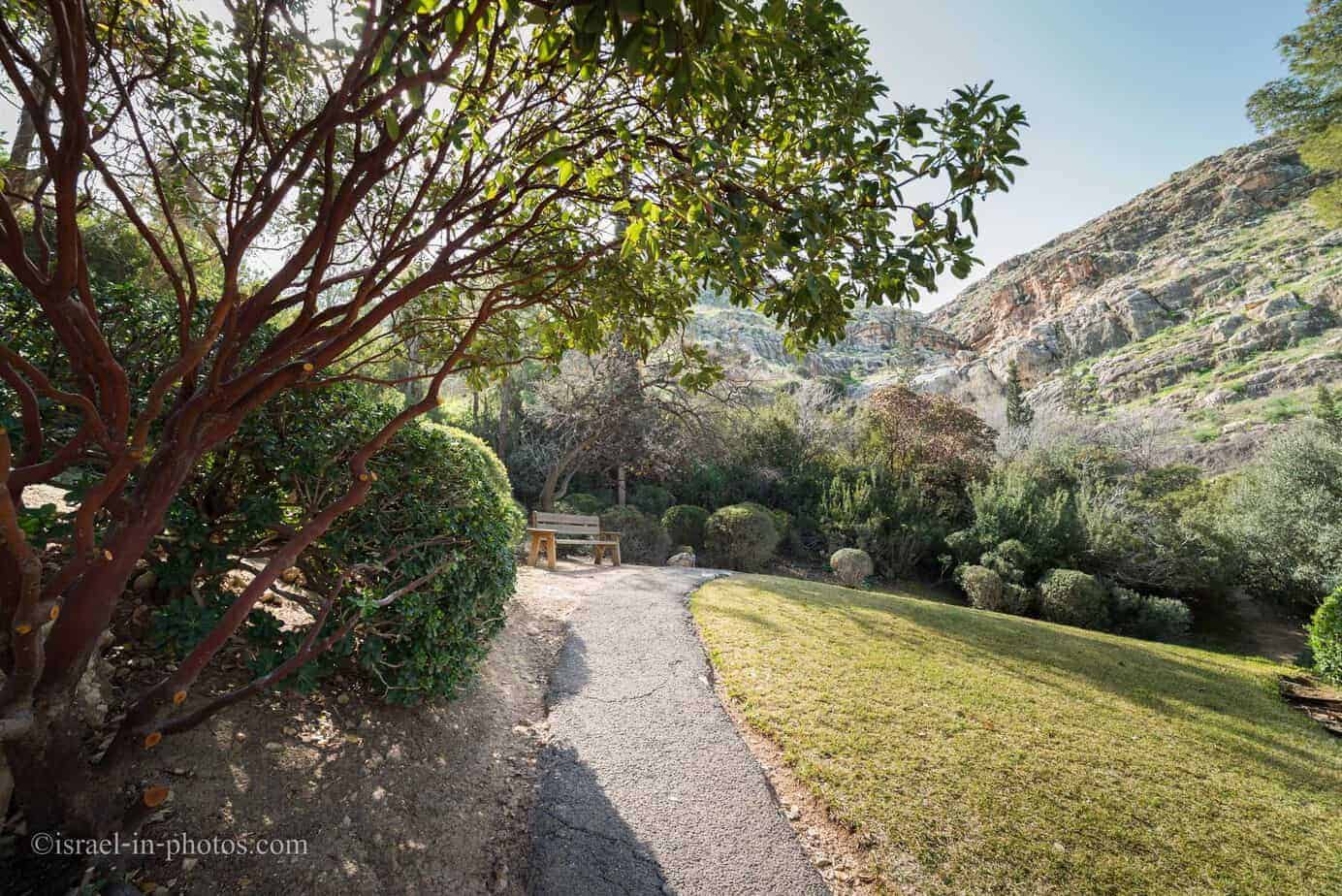
Wadi is the Arabic and Hebrew term traditionally referring to a valley. In some instances, it may refer to a dry riverbed that contains water only during times of heavy rain.
Source: Wikipedia
Why did I mention the wadi? In ancient times Bet Shean was a Roman city. And Jews lived in the surrounding areas. There is not much water in the valley. Thus they constructed a cave to collect all water from the wadi.

Today wadi’s water entrance to the cave is closed, and the cave is used for praying (though Makuya members do not have a dedicated praying place, like churches).

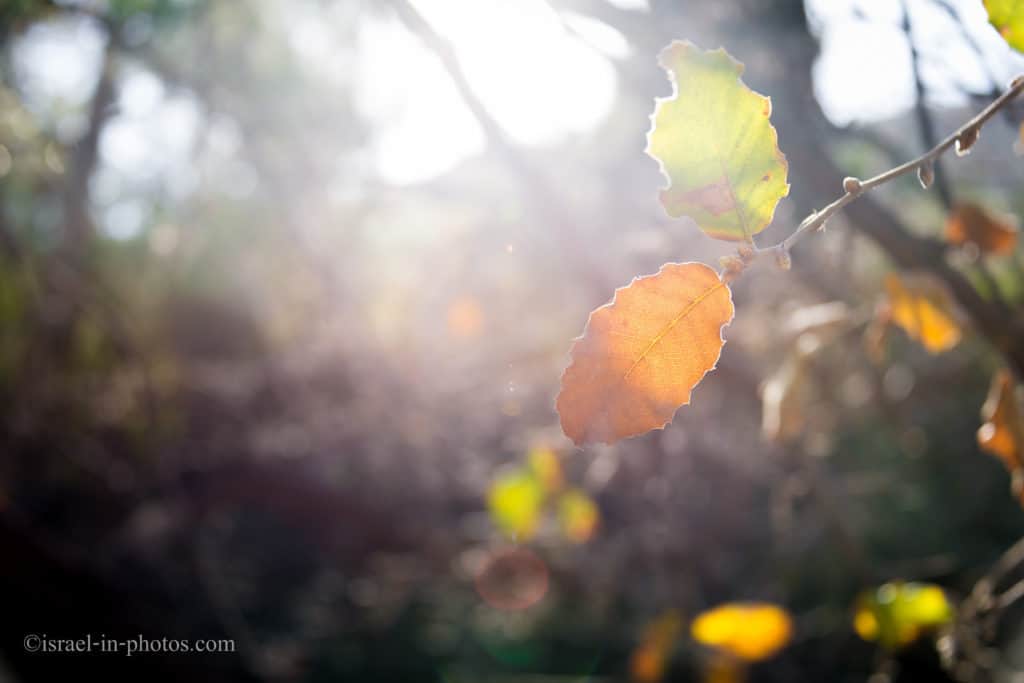

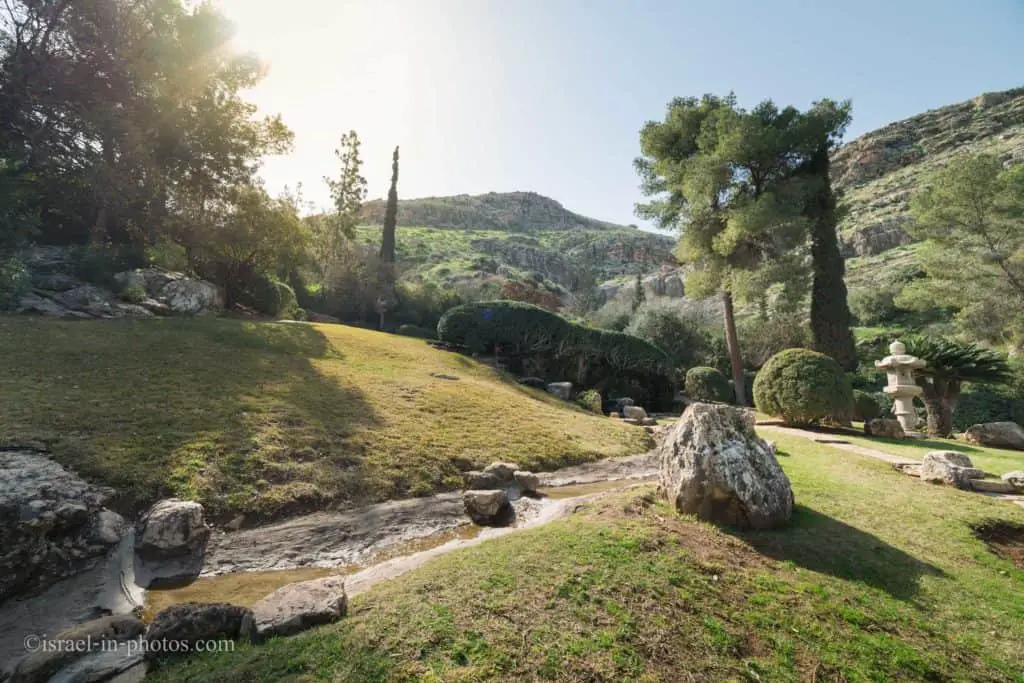
A shishiodoshi is a garden device made of bamboo and wood designed to scare away birds. As the bamboo tube fills with water, it clacks against a stone, empties, then fills with water again.
You can see a model of a shishiodoshi in the garden:


The five stones in the upper pool represent Japan’s five main islands.
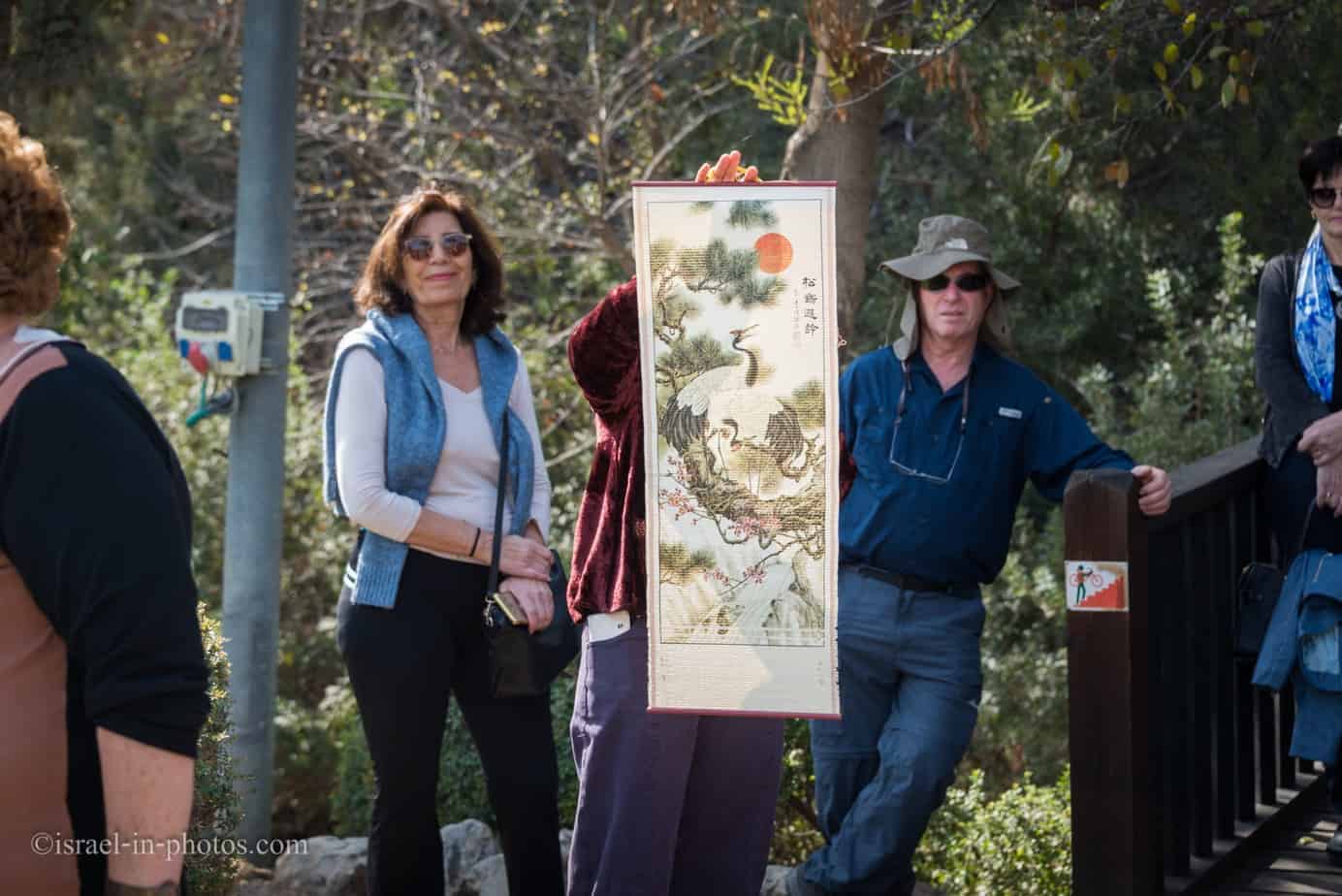
After understanding some of the symbols, Naama showed us gifts she received from Makuya members and explained their meaning.
Thousand Origami Cranes
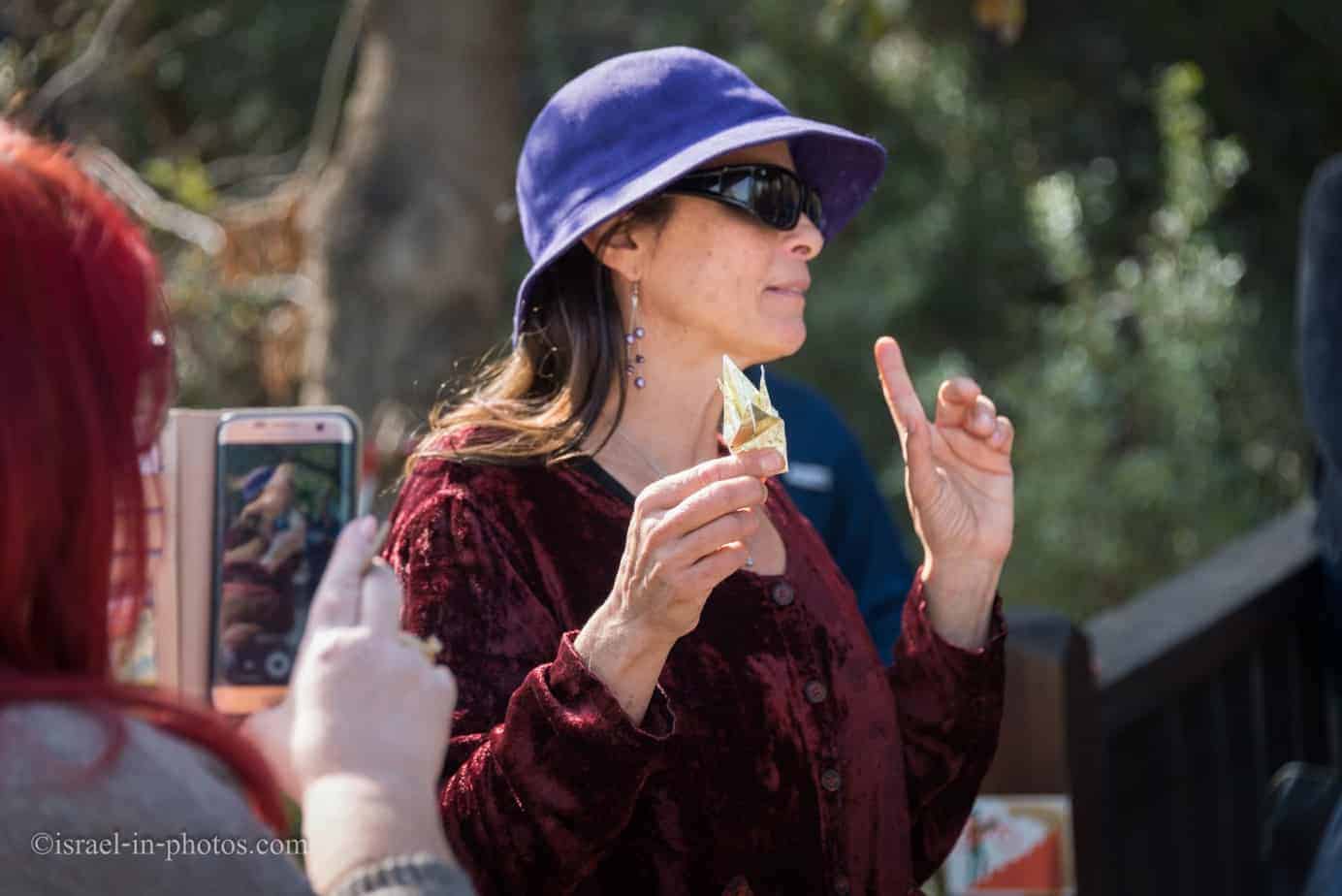
She told us about one thousand origami cranes. An ancient Japanese legend promises that the Gods will grant a wish to anyone who folds a thousand origami cranes. Some stories believe you are granted eternal good luck instead of just one wish, such as long life or recovery from illness or injury.
One thousand origami cranes became popular through the story of Sadako Sasaki, a Japanese girl who was two years old when she was exposed to radiation (during the bombing of Hiroshima). Sasaki soon developed leukemia and, at age 12, after spending a significant amount of time in a hospital, began making origami cranes with the goal of making one thousand. She folded only 644 before she became too weak to fold anymore and died in October 1955. Her classmates were touched by her story and completed the task for her.
Today there is a statue of Sadako holding a crane in the Hiroshima Peace Park, and every year on Obon Day, people leave cranes at the statue in memory of the departed spirits of their ancestors.
This is how origami cranes look like when stacked:

This was almost the end of our tour. The tour lasted a little more than an hour. And it was more than a visit to the Japanese garden. It was a taste of Japan.
We enjoyed this tour, and it is one of those places where you need a guide. Moreover, I understood from Naama that she changes the topic of the tour monthly. Thus, you can visit the Japanese garden more than once.
Since the garden is not big, you can combine it with other attractions in this area (like Bet Alfa Synagogue, Gan Garoo, and Bet Shean). Naama recommended a short hike along the Gilboa, and so we did.
You can see this bridge in the park, leading to a trail along Gilboa mountain.
Gilboa trail
The trail is a wide road and offers lovely scenic views of the valley. Furthermore, since it was February, many trees and flowers bloomed.
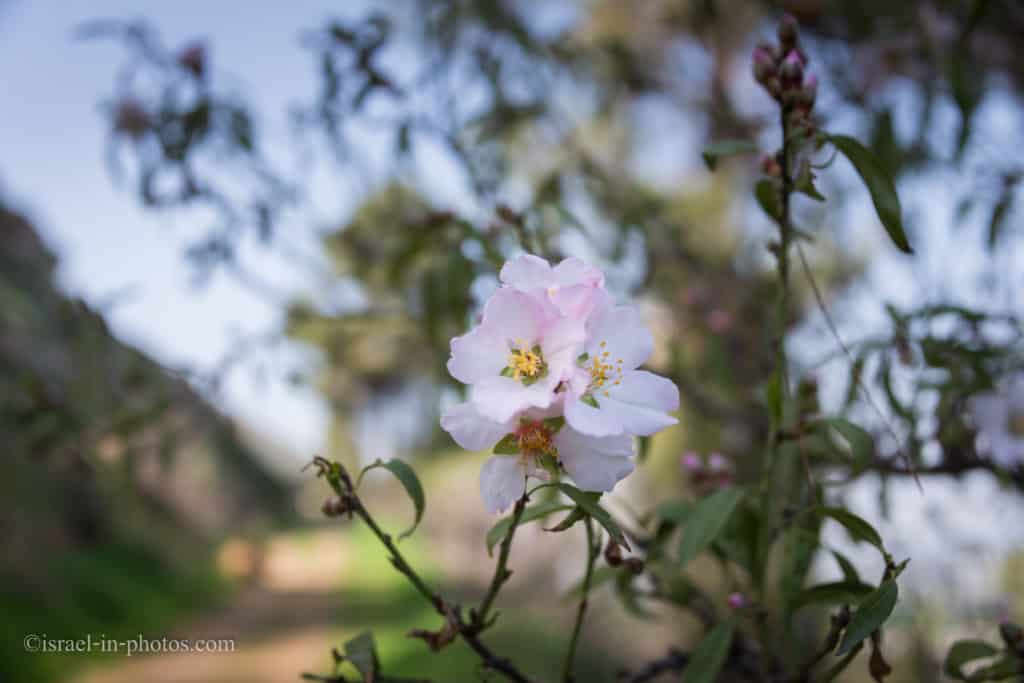

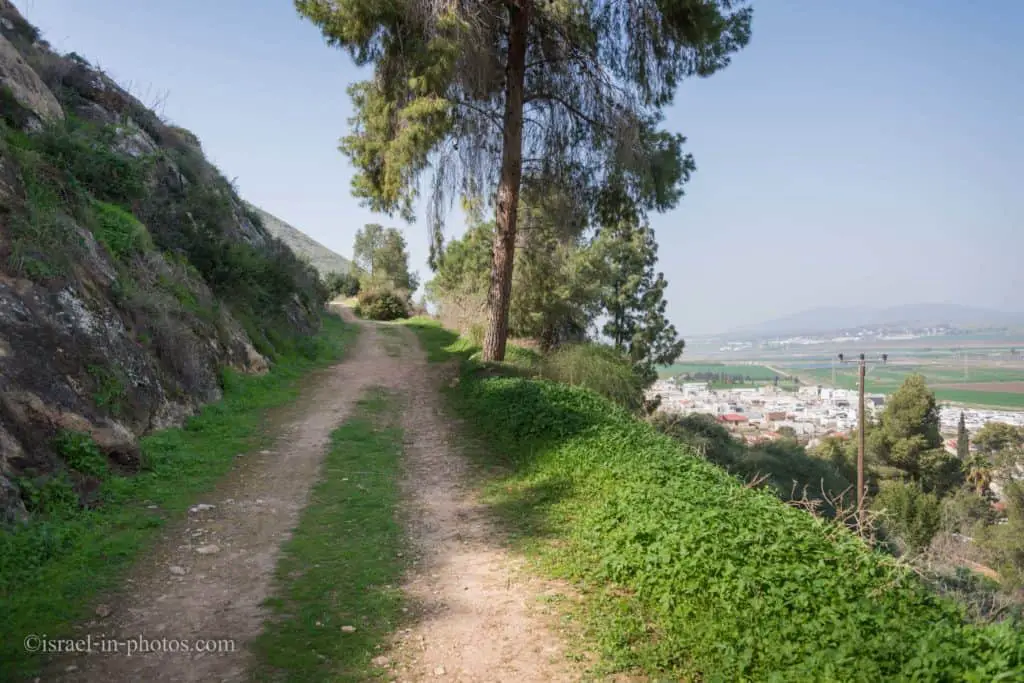
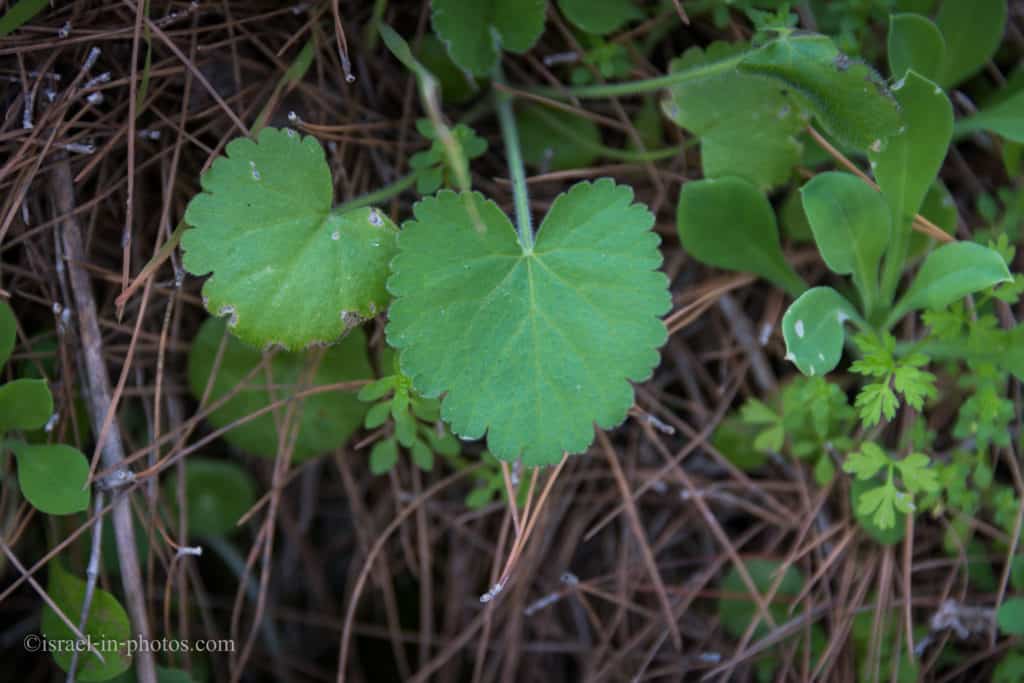

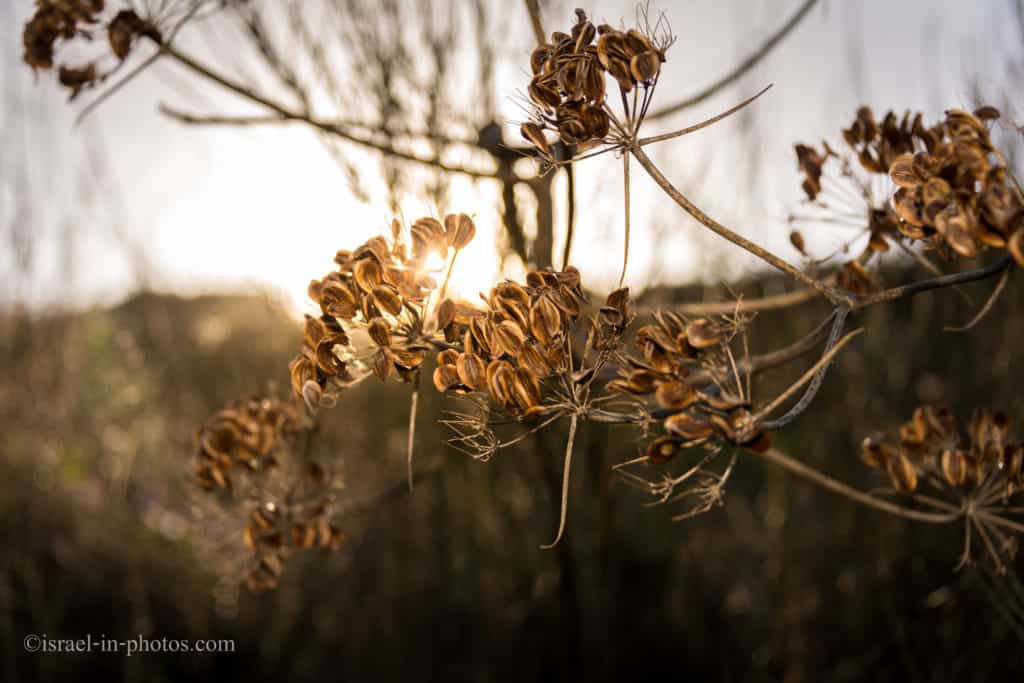
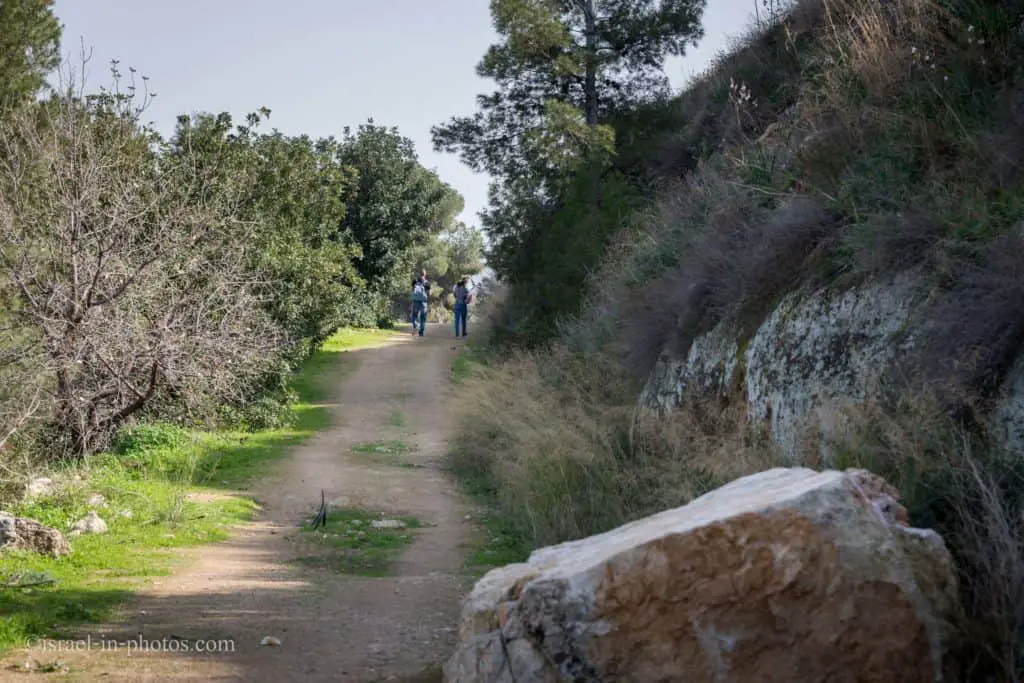

Cyclamen is Medieval Latin, from earlier Latin cyclamīnos, from Ancient Greek kyklā́mīnos, probably from kýklos “circle”, because of the round tuber.
Source: Wikipedia




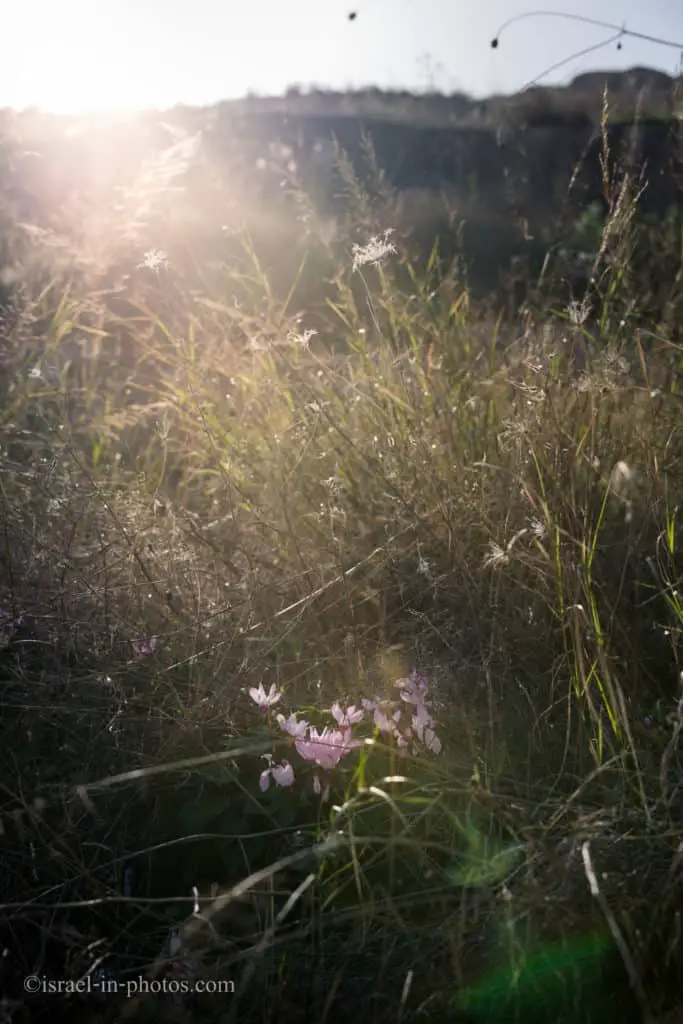
As we walked, we saw leaves being “born”. There were many at different stages of development, some on very early ones and others on more advanced ones (like the following).

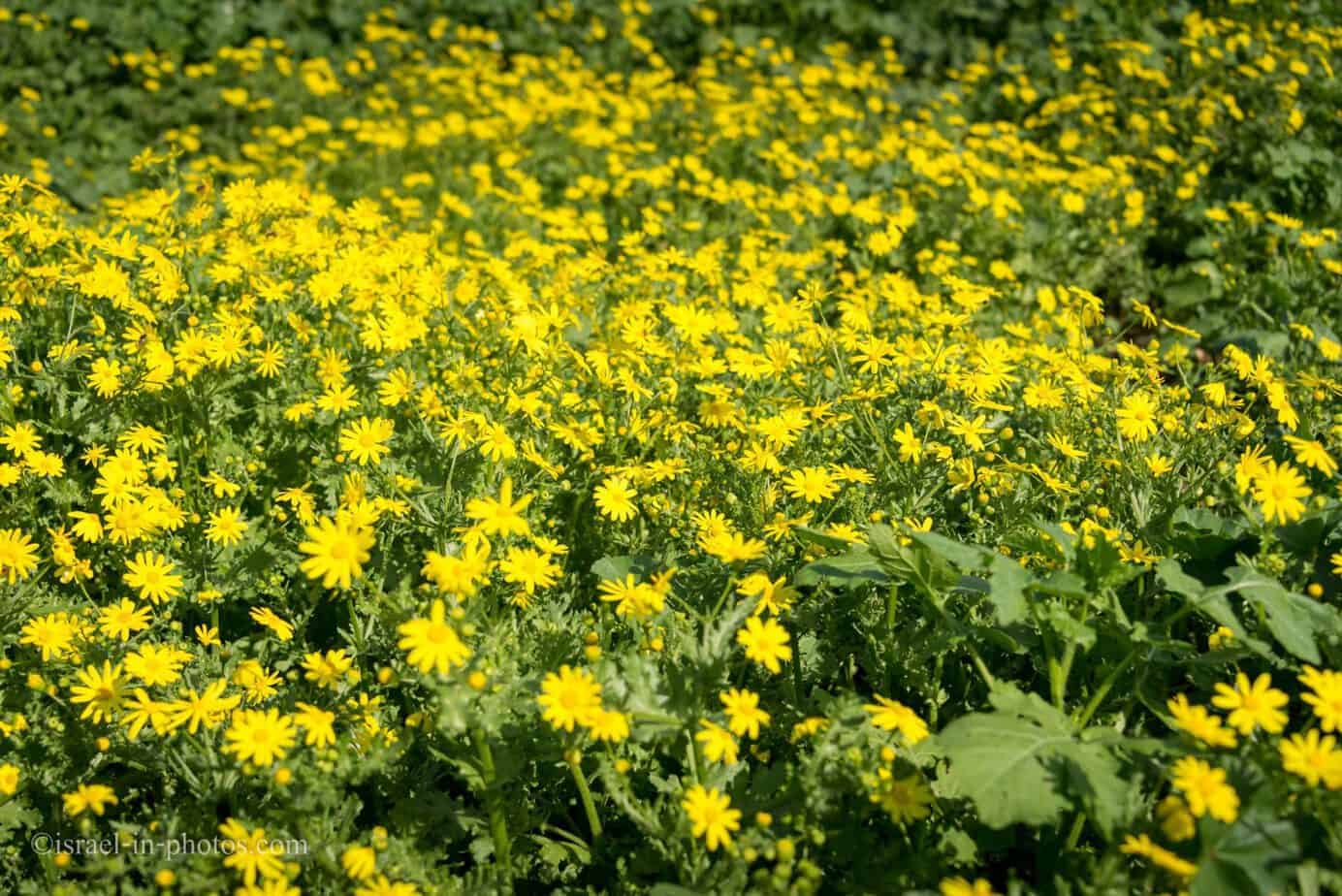
Heftsiba Quarry
Another nearby point of interest is Heftsiba Quarry (this is what the sign said, though most places write Hephzibah and not Heftsiba). It’s five minutes drive from the garden (turn left when exiting Kibbutz Hephzibah and follow the signs).
Heftsiba Quarry is an open site with nearby parking.
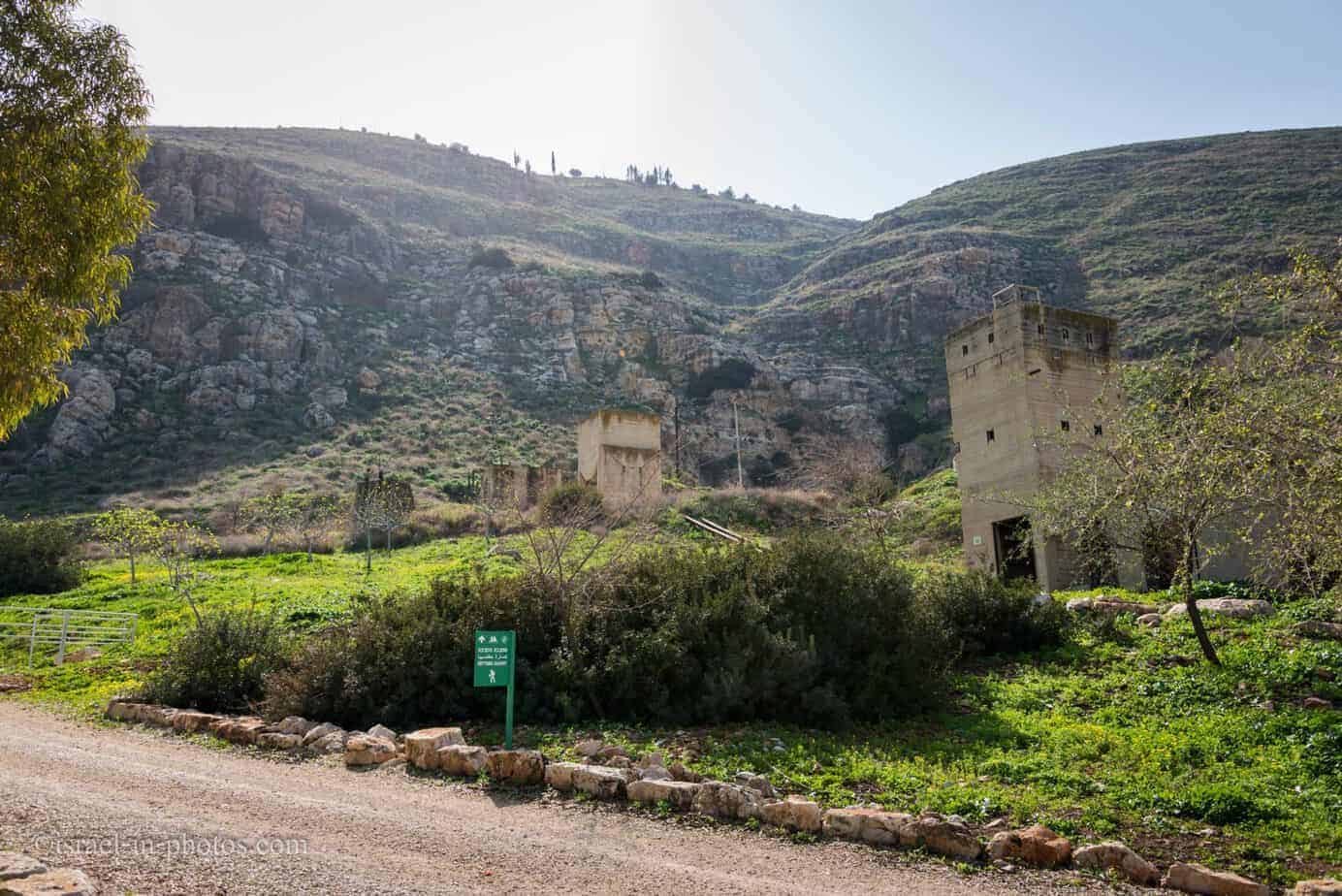
With the start of the Second World War, marble imports from Italy stopped. “Even and Seed” (Stone and Lime in Hebrew) company looked for a site with marble in the vicinity of the Kibbutz. During one of the rides to the “Even and Seed” location, workers from Hephzibah noticed a marble lode exposed on Gilboa. Based on this discovery, a group of people was sent to Carrara, Italy. They bought equipment for the marble quarry and created Heftsiba Quarry.
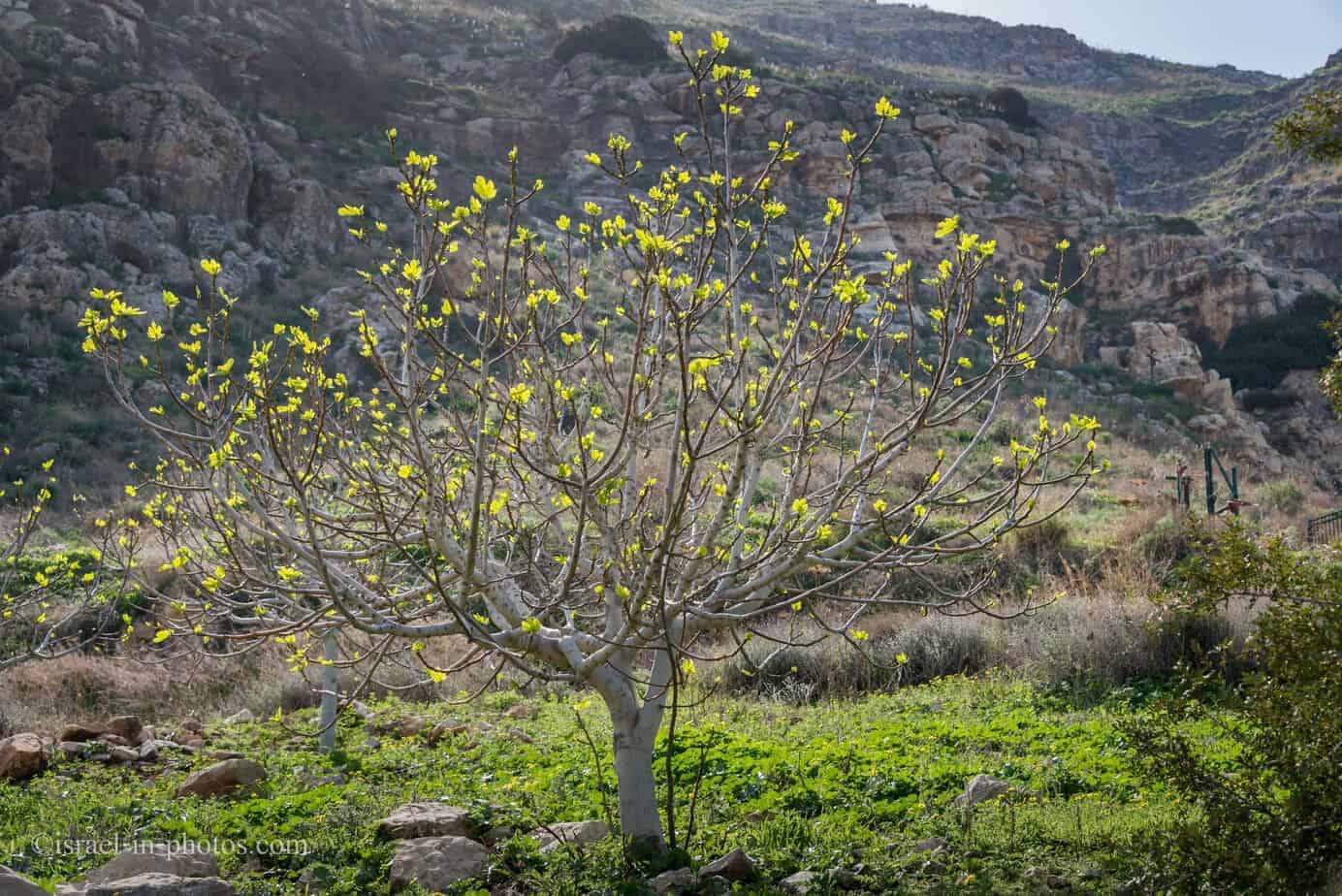

Close to the quarry, you can find this small building. The sign says that it is a 100 meters depth well. The well was created in 1965 and is active to this day.
Heftsiba Quarry system was based on a 4mm cable. The cable slid along wheels, and weights along the cable pressed it down towards the stone. As this process took place, workers put sea sand with water on the top of the cable. Here is a restoration of the cutting system:

Heftsiba Quarry was active from 1942 till 1952.
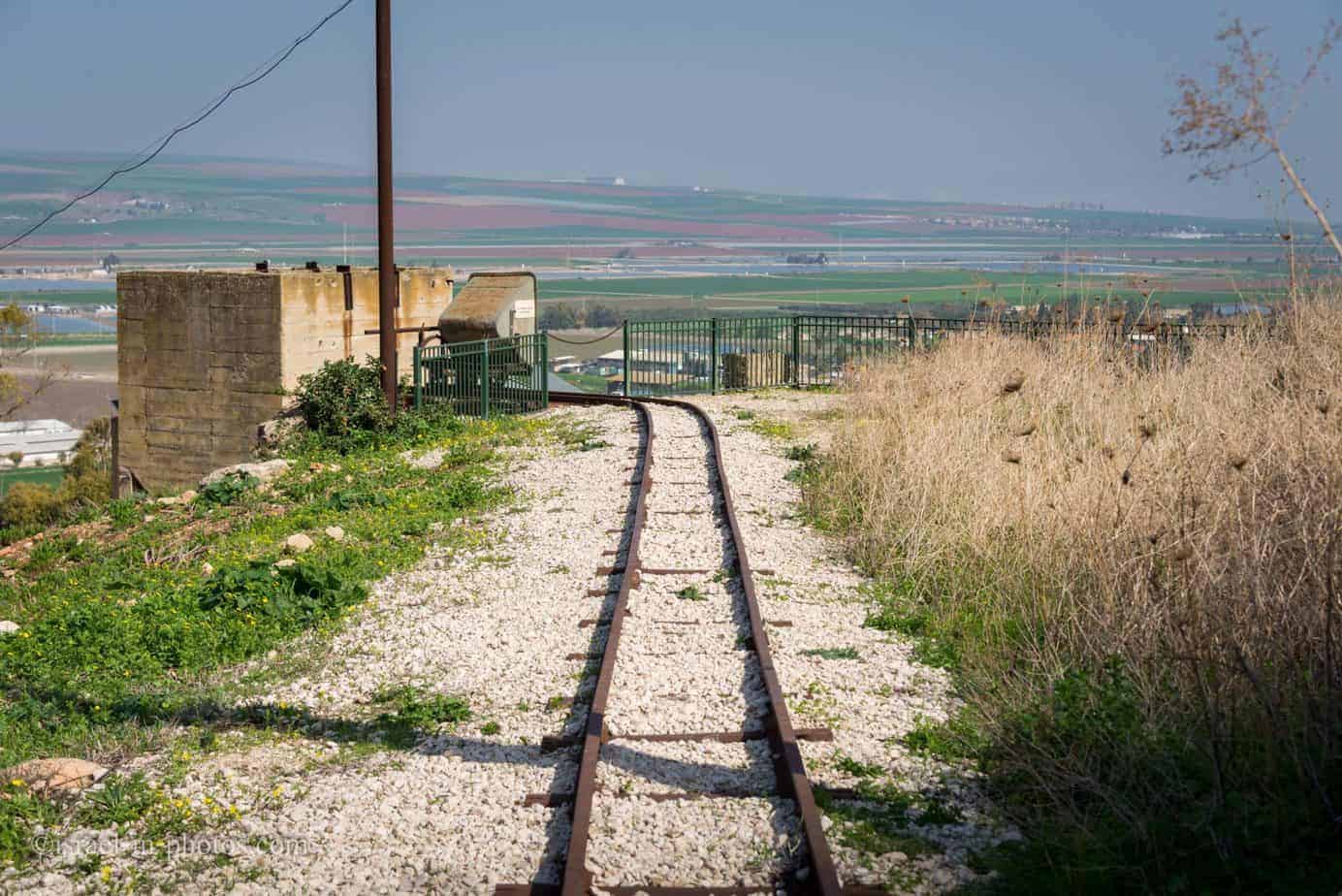
Close to Heftsiba Quarry, we saw Harod Valley’s lookout. This is the view from it:
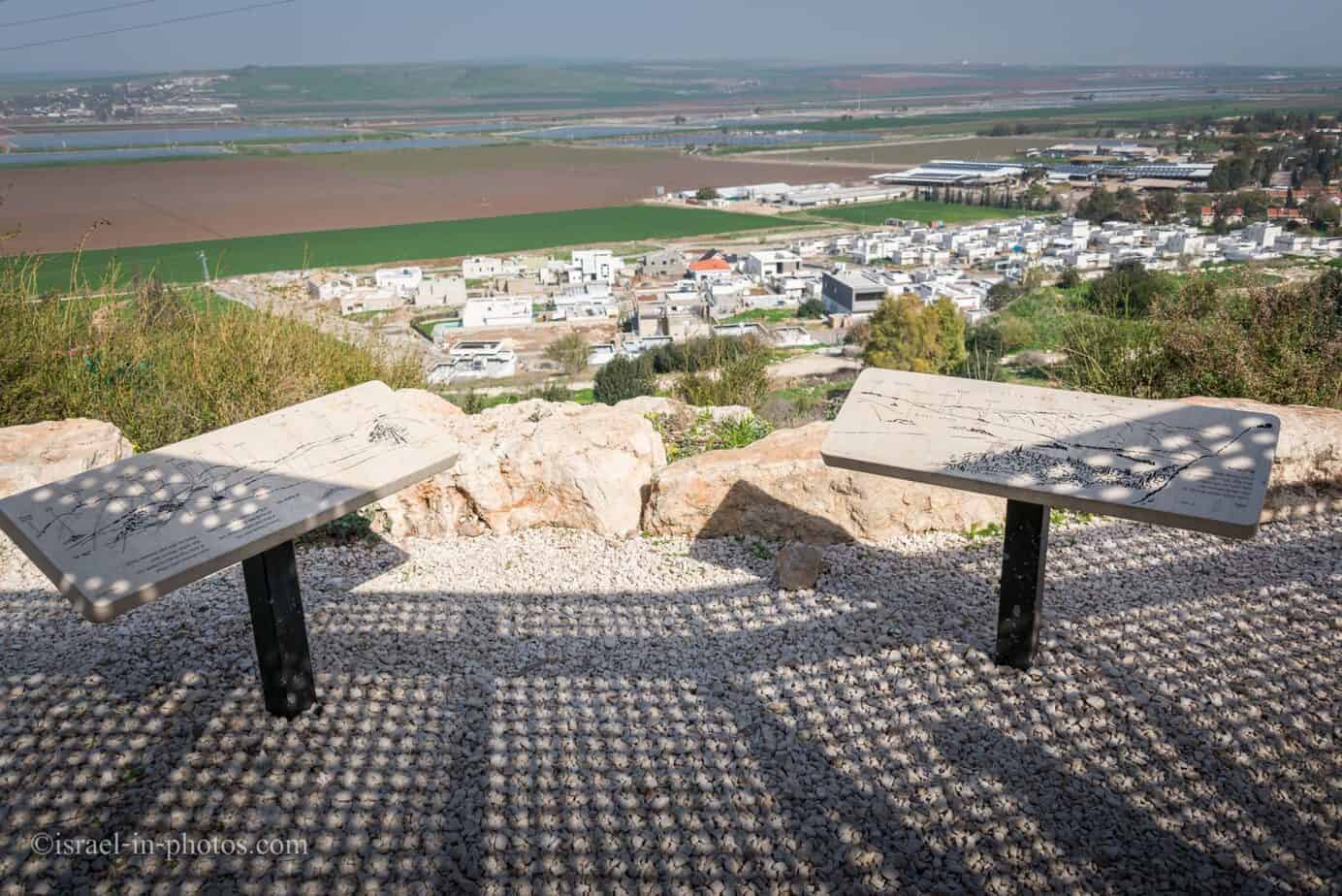

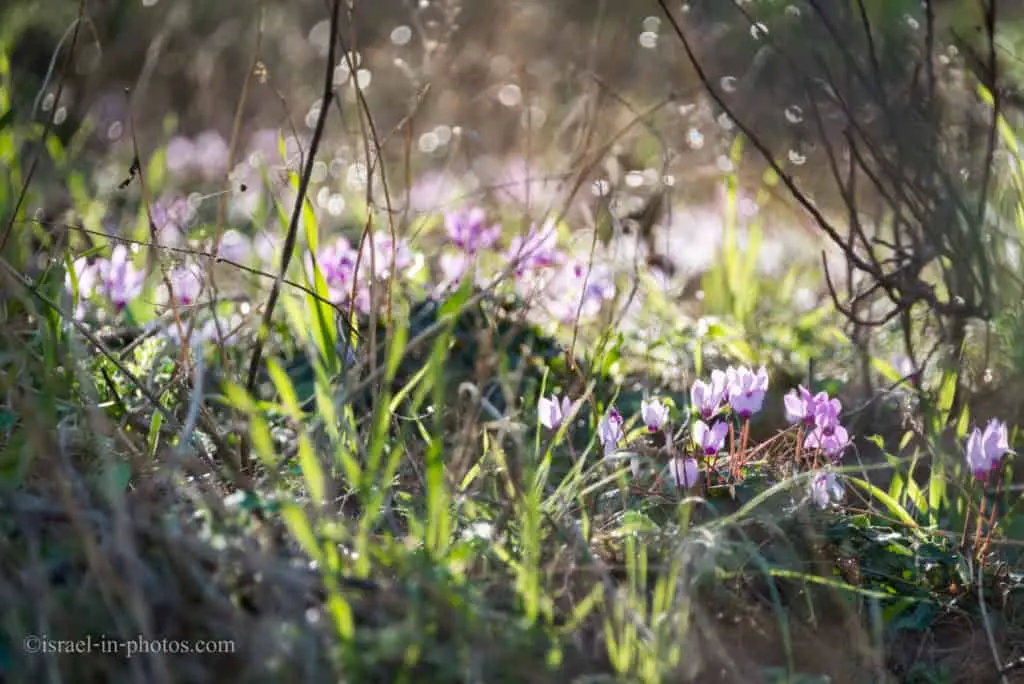
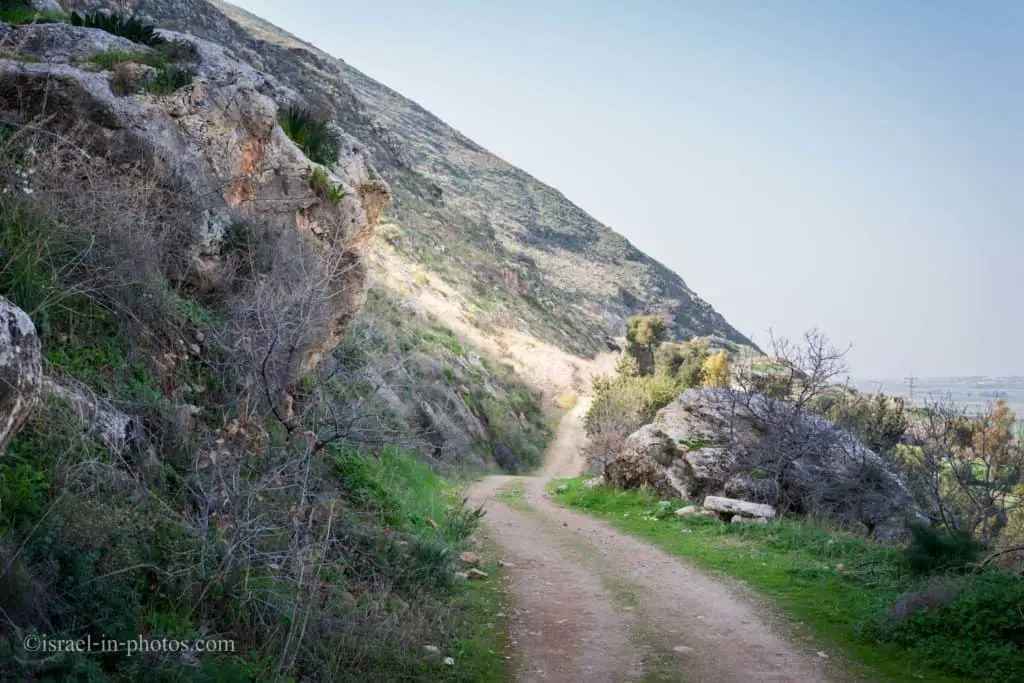
These were enjoyable several hours, but it was already lunchtime, and we were getting hungry. So it was time to hit the road.
There are several dining options in the area. You can check out Dag Dagan fish restaurant in the Kibbutz. Or visit Beit Hashita. At the entrance to Beit Hashita, there is a gas station. There is a small center with several restaurants by the gas station. If you want to continue the Japanese theme, there is the Yakinton noodles bar. We dined at Tur’ani restaurant, which offers pretty good middle eastern dishes.
That’s all for today, and I’ll see you in future travels!
Stay Tuned!
Disclaimer: I was invited to the Japanese Garden by Naama to write a post about the garden. I joined an actual tour and expressed my own opinions.
Additional Resources
Here are several resources that I created to help travelers:- Trip Planner with Attractions and Itineraries is the page that will help you create your perfect travel route.
- What is the Best Time to visit Israel? To answer this question, we will consider the weather, prices, holidays, festivals, and more.
- Information and Tips for Tourists to Israel will answer the most common questions tourists have about Israel (including safety, passports, weather, currency, tipping, electricity, and much more).
- Israel National Parks and Nature Reserves include a complete list, top ten, map, tickets (Israel Pass, Matmon, combo), and campsites.
- If you are looking for things to do, here are the pages for Jerusalem, Tel Aviv, Haifa, Sea Of Galilee, Akko (Acre), Eilat, Nazareth, Safed (Tzfat), and Makhtesh Ramon.


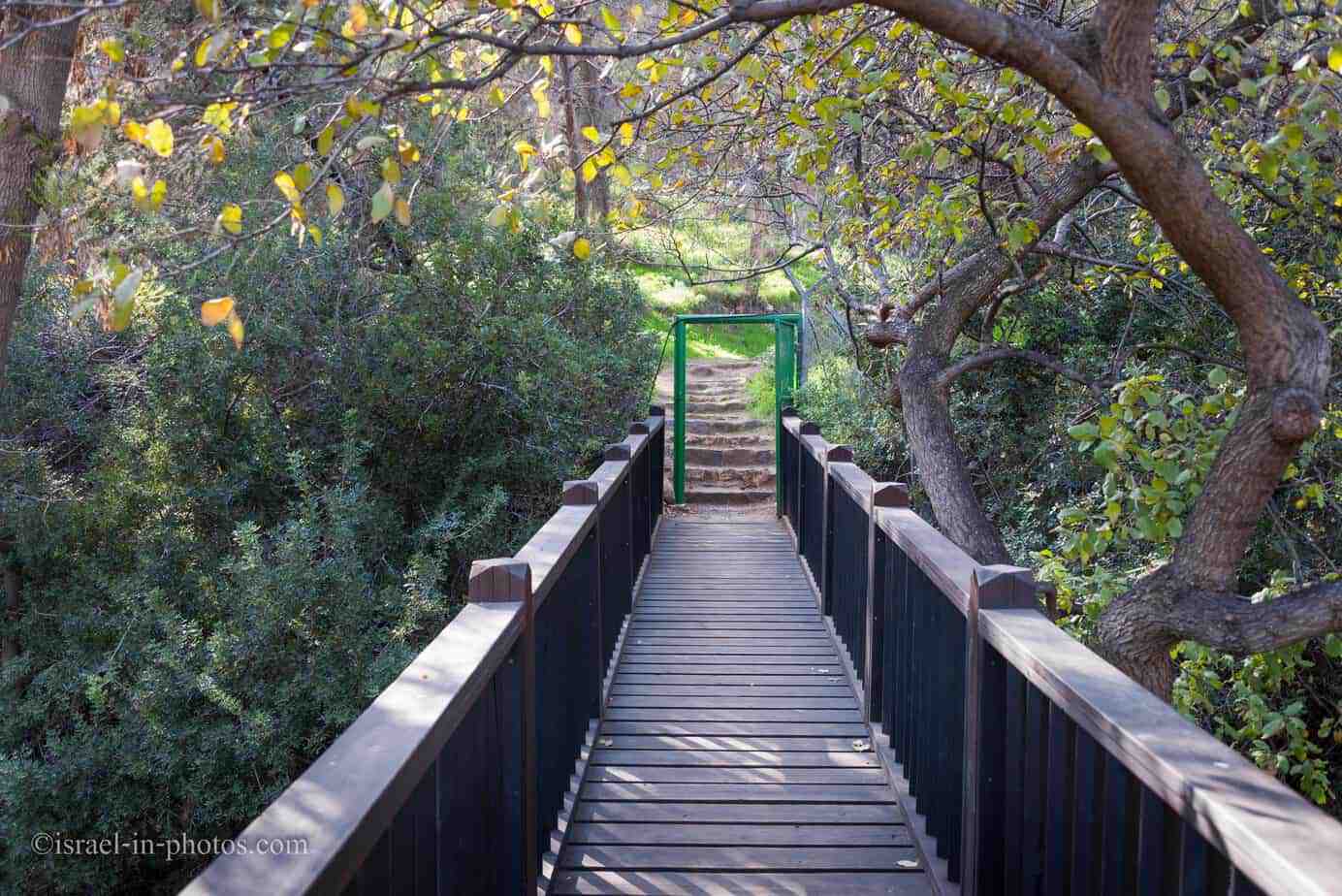

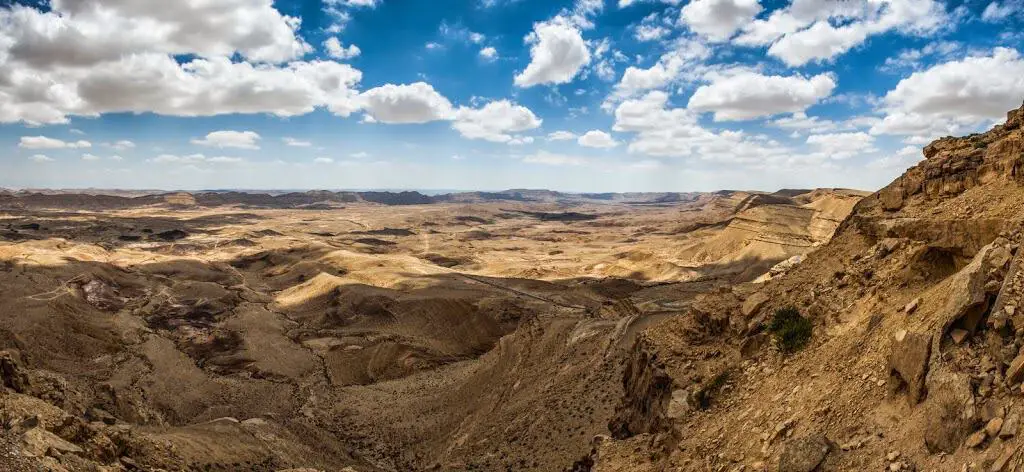


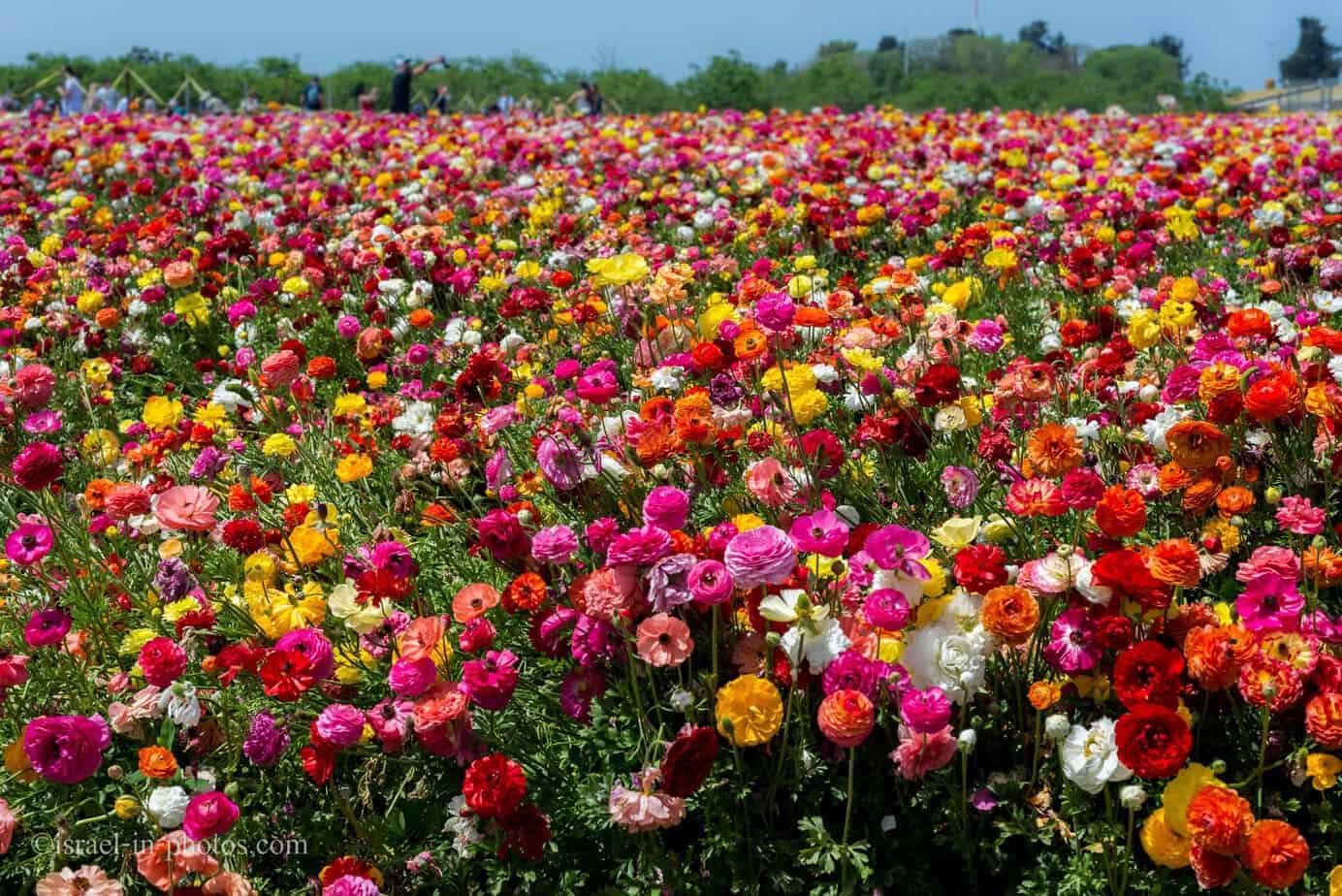
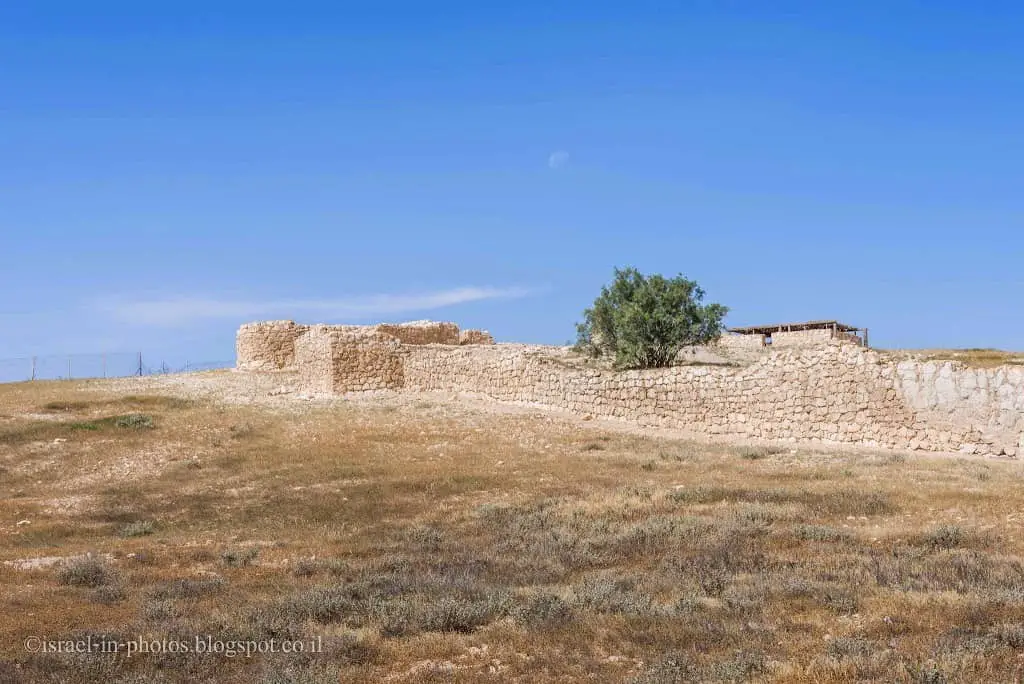
I’m not that much of a internet reader to
be honest but your sites really nice, keep it up! I’ll go ahead and bookmark your website
to come back down the road. Many thanks